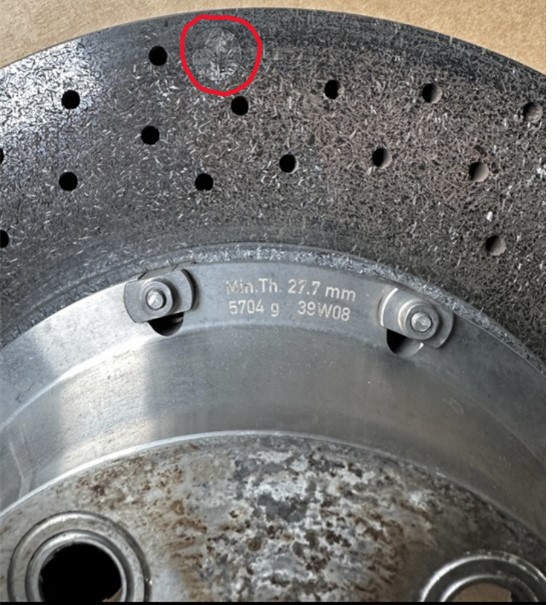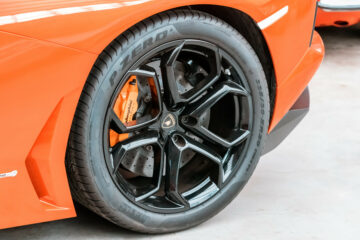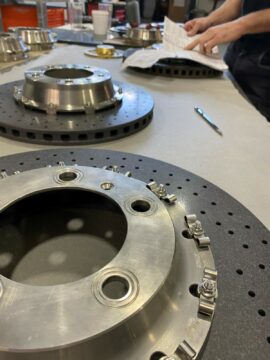Issues with AUDI RS6 C6 carbon-ceramic brake discs
The Audi RS6 C6 is an RS6 model that features the well-known V10 engine and is equipped with carbon-ceramic brake discs. In addition to the RS6, the Audi S8 is also equipped with this brake technology. This braking system can be quickly identified by its dark grey brake callipers with “Audi Ceramic” written on them and carbon-ceramic discs. The discs are 420mm in length at the front and 356mm at the rear.
In addition to the advantages offered by carbon-ceramic discs, there are also some disadvantages.
- Oxidation of bolts
- Cracks around the brake core mounting points on the hub
- Delamination (separation of material from the braking surface)
- High cost of purchasing new CCBs
Oxidation of bolts
We regularly receive worn Audi RS6 or S8 brake discs with mostly oxidised mounting bolts and brake discs. Oxidation is caused by water and road salt. Normally, oxidation is not dangerous for CCB discs, but it is a problem for the Audi RS6 and S8.
Why? The oxidised bolt is not placed between the bolt and the washer, but is in direct contact with the ceramic carbon. This, of course, creates tension between the carbon-ceramic material around the mounting bolts. Visual changes occurring in the area of the mounting bolts are easily noticeable.
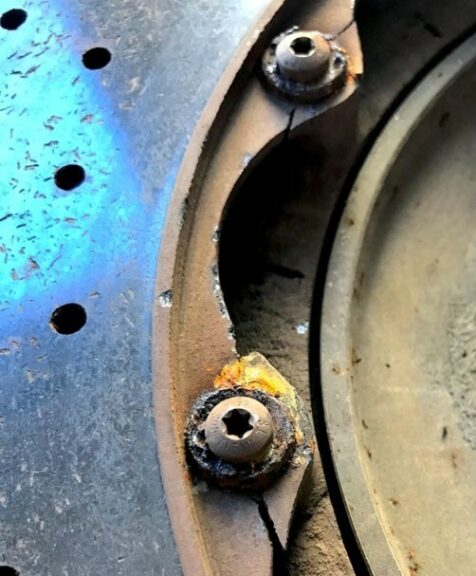
Photo Here
Cracks around the brake core mounting points on the hub
Oxidation occurs around the mounting points and this is a weak point in carbon-ceramic discs.
Oxidation not only causes stresses in the material, but also causes the carbon-ceramic material around the bolts to crack. As there is no more room for oxidation to spread, the material around the bolts connecting the brake disc to the aluminium hub breaks. These cracks weaken the brake disc to the point where it is no longer safe to continue driving.
You cannot see the crack when the brake disc is on the vehicle, as this part is located on the inside of the disc. This means that you need to take the disc out of the vehicle and inspect it thoroughly.
If you don’t already have cracks, we advise you to prevent oxidation by cleaning off the salt regularly and not using harsh cleaning products.
Redisc’s technology prevents oxidation by using OXY coating, which protects the carbon fibres and reduces the chance of the carbon-ceramic discs cracking.
Delamination Carbon Ceramic Brake Discs
Cracks in the material around the mounting bolts are one of the most dangerous damages to this type of brake disc. Another unwanted side effect that can occur with carbon-ceramic brake discs is delamination.
This means that parts of the top surface of the carbon disc peel off from the whole structure. These can be seen as surface abrasions. There are various reasons why this happens:
- Poor disc structure
- Mechanical damage
- Driving
For example: You drive your car at a relatively high speed, the discs get heated to above 300 degrees, and then you stop at a traffic light. When you press down on the brake pedal, the brake pads are pressed onto the hot discs, and if the brake pads contain too much metal, the layer sticks to the disc and when you drive off, the pad delaminates the top layer of the disc.
How to prevent delamination:
Always let the discs warm up first and, when you stop after a fast journey, put the car in neutral and apply the handbrake.
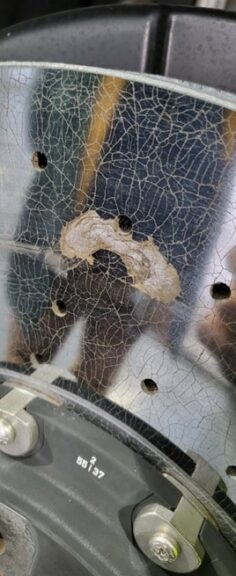
Indicators Carbon Ceramic Brake Discs
Do you think your brake disc is still working well because it looks fine; however, it feels rough to the touch and the indicator is hard to see?
The dots on the carbon-ceramic discs are wear indicators. As soon as the discs become rough and the dot is no longer clearly visible, the carbon-ceramic discs are no longer suitable for use and cannot provide full braking safety.
There is nothing you can do about the indicators, and the discs and brake pads need to be replaced urgently.
Redisc can completely restore and renew your disks. But don’t wait too long. If the carbon-ceramic discs are too worn, there is a high chance that the disc will become too porous and cannot be restored.
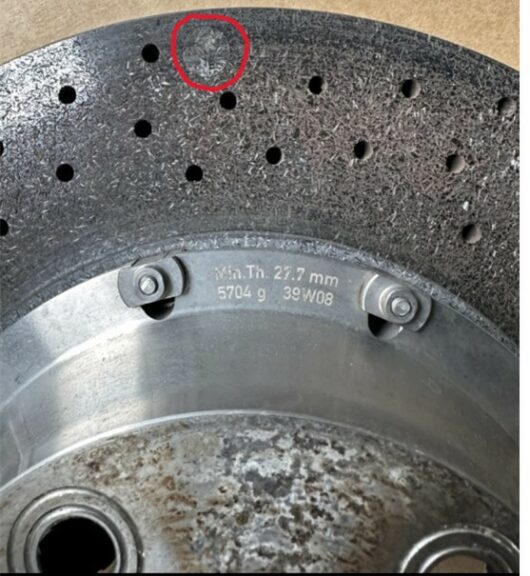
High-end new carbon-ceramic brake discs for the Audi RS6 C6
Many of our customers are extremely satisfied with the technological solutions our company offers. By comparison, the prices of new carbon-ceramic discs for the Audi RS6 exceed €4,500 + VAT.
By detecting problems or damage in time, we can save you significant costs. The average saving on our service is 70% compared to buying new, yet despite the high savings, the quality is the same as getting new discs. This is verified by measurements performed by Carboteq More here
To prevent corrosion, after repairing damaged carbon-ceramic brake discs, we fit on new bolts or treat the reused bolts against oxidation.
Similar defects and problems with carbon-ceramic discs, in addition to the Audi RS6 C6 (2008-2010), can also be found on the Audi S8 8E (2006-2010), the Bentley Continental GT (2003-2011), the VW Phaeton (2002-2010), some Rolls Royce models (2005-2010) and the Porsche 991 (2016-2019). More info you can find: Here
